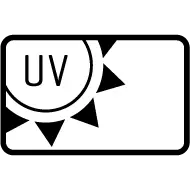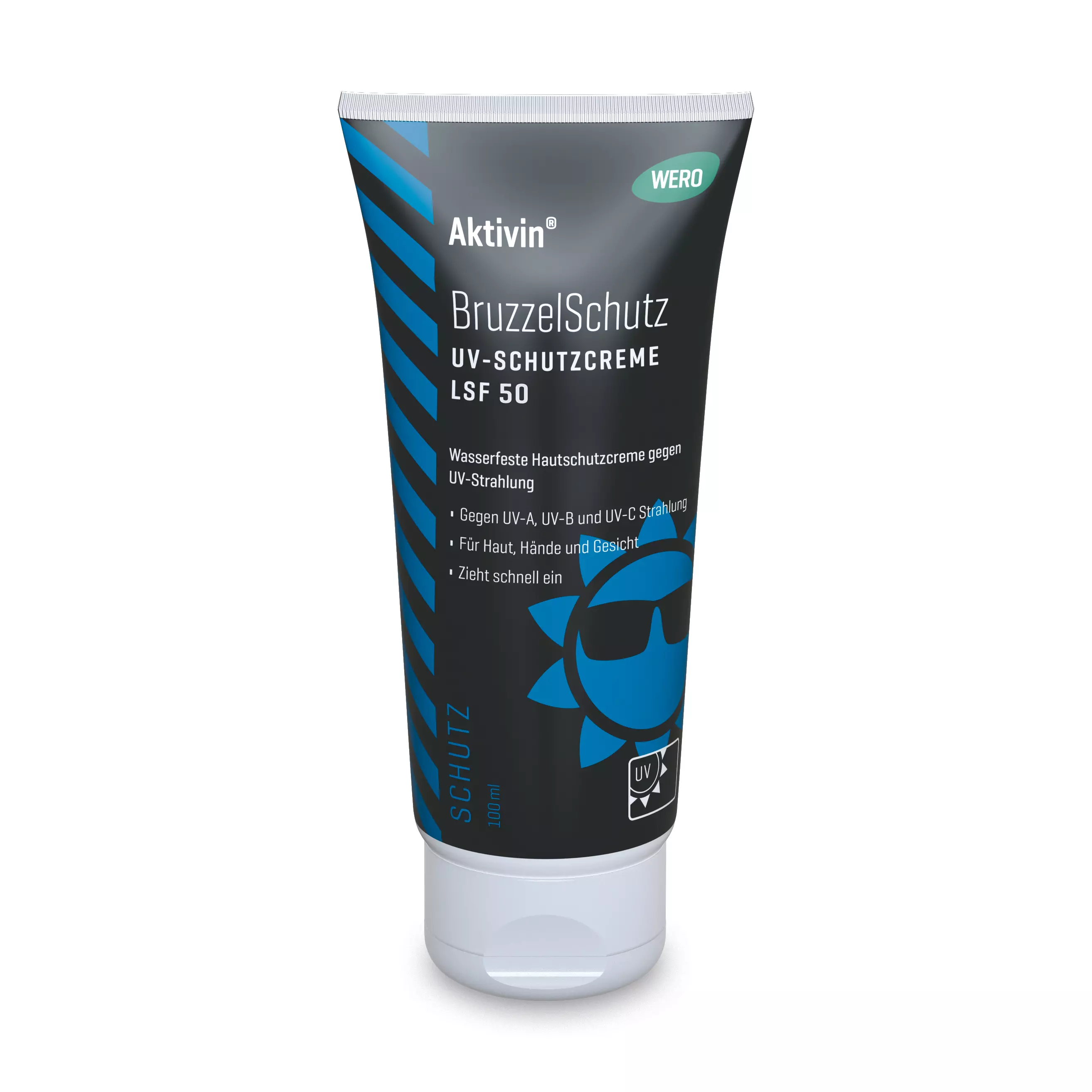UV protection cream Aktivin® BruzzelSchutz SPF 50, 100 ml
€17.04 *
Available, delivery time: 1-3 days
€17.04*
€15.39*
Waterproof protection against natural UV radiation when working outdoors
and against artificially generated UV radiation, e.g. during electric welding.
Particularly light, fast-absorbing consistency. With panthenol. Suitable for
all skin types.
UV protection cream for the skin
Anyone who works outdoors or is exposed to artificially generated UV radiation, such as when welding or working with a gas torch, must protect their skin with UV protection cream. In addition to solar radiation, radiation from artificial UV sources can also cause painful sunburns and skin cancer if you do not protect yourself adequately. With our sun protection cream, we offer you reliable protection against sunburn, skin damage and premature skin ageing. The cream is quickly absorbed, waterproof and has a high sun protection factor. But how does a UV protection cream work and what effects do the different types of UV radiation have?
The principle of action of UVA, UVB and UVC rays
Ultraviolet radiation is electromagnetic radiation that is imperceptible to the human eye. The natural source of these short-wave rays is exclusively sunlight, which we are exposed to whenever we are outdoors. Even when the sky is overcast, these rays reach the earth's surface in a mild form. On hot days with a cloudless sky, the sun unfolds its full intensity. Unprotected skin is exposed to ultraviolet radiation and its damaging effects.
UVA rays are characterised by long UV waves with low energy. They are able to penetrate deep into the skin tissue down to the dermis. Although they are responsible for the direct pigmentation of the skin, they only produce a tan that lasts a few hours. At the same time, UVA radiation damages the collagen in the skin, which ages prematurely as a result. Although these rays are hardly capable of causing sunburn, they increase the risk of melanoma, i.e. the occurrence of malignant skin cancer. A special UV sun protection cream protects against this skin damage.
UVB rays are medium-wave rays and penetrate less deep layers of the skin. They are essential for the formation of vitamin D and are responsible for the delayed formation of melanin by around 72 hours. This results in a long-term tan and provides the skin with light protection, which is particularly important in summer. Without sun protection, UVB rays cause sunburn on the skin, which is often very painful. Although these rays are responsible for a healthy tan on the skin, they are also dangerous: they have a particularly high carcinogenic effect and are considered prominent triggers of skin cancers such as basal cell carcinoma or squamous cell carcinoma.
UVC rays are the highest-energy, short-wave rays. They do not normally occur on the earth's surface, but are largely filtered out by the ozone layer in the atmosphere. However, UVC rays are generated, for example, during arc welding and when working with gas burners. They are extremely aggressive and cause sunburn in a very short time. In principle, however, UVC rays are even capable of killing microorganisms and are therefore used in the decontamination of foodstuffs, among other things.
UV filters - the most important ingredients in every sun protection cream
The Working Group for Dermatological Prevention recommends applying a UV protection cream or general sun protection by covering the skin when spending ten to 15 minutes outdoors. While a day cream with a sun protection factor is sufficient in cooler temperatures, a good sun cream is highly recommended in summer.
An effective UV protection cream is equipped with a reliable UVA, UVB and UVC filter. These dissolve well in the sun cream and spread evenly throughout the cream. When applied to the skin, they create an invisible protective film that absorbs harmful UV rays.
Instructions for applying sun cream:
- Apply UV protection cream for the first time 30 minutes before UV exposure or sun contact.
- Use plenty of UV protection cream!
- Pay particular attention to protecting your lips, ear rims, nose, décolleté and, if necessary, the backs of your feet.
- Reapply sun cream every two hours and after every swim.
- Take the sun protection factor into account.
- Sun cream does not extend the time spent in the sun by reapplying it several times.
The sun protection factor in UV protection cream
The higher the sun protection factor of a sun cream, the longer you can stay in the sun without unpleasant consequences. The exact details of this factor can be found on the various products under the abbreviation SPF. However, the optimum amount of time you can spend in the sun without damaging your skin depends on various factors. First and foremost, this is your skin's own protection time. This is an aspect that is often given too little attention and is not known to many sun lovers.
The most common classification is the categorisation according to Thomas Fitzpatrick, an American dermatologist. He differentiates between six different skin types with different self-protection times. In the following list, the recommended sun protection factor is based on the UV index 9+, strong sunlight:
- Type I, very light skin colour: 10 minutes, SPF 25 - 35
- Type II, light skin colour: 10 - 20 minutes, SPF 20 - 25
- Type III, medium skin colour: 20 - 30 minutes, SPF 15 - 20
- Type IV, brownish skin colour: more than 30 minutes, SPF 15
- Type V, dark skin colour: more than 90 minutes, SPF 8
- Type VI, very dark skin colour: more than 90 minutes, SPF 4
If you know your personal self-protection time, it is easy to calculate the optimum length of stay in the sun for you. Multiply the self-protection time of your skin by the sun protection factor indicated on the UV protection cream. The result is the amount of time you can spend in the sun without regret. If you prefer to play it safe, reduce the result by 40 per cent.
Sun protection cream at the workplace
Where employers cannot prevent direct skin contact with UV rays, they must provide their employees with UV sun protection cream in accordance with the Occupational Health and Safety Act. We recommend applying the cream to the areas of skin at risk before spending time in the sun. The prerequisite for this is that the skin is clean and dry. Employees should always reapply cream, especially after washing or after sweating heavily. To optimise the workflow in your company, we recommend our "Use skin protection products" sign. For good reason, your employees should always remember that they need to use sun cream to protect themselves from sunburn and the generally damaging effects of UV rays, such as their carcinogenic effects.
The risk of developing skin cancer from work-related UV radiation has now been proven. Since 1 January 2015, squamous cell carcinomas and actinic keratoses have been recognised as occupational diseases by the Federal Ministry of Labour and Social Affairs (BMAS).

| Brand name: | Activin® |
|---|---|
| Bulky goods: | No |
| Container: | Tube |
| Container type: | Tube |
| Freight surcharge: | No |
| Product features: | UV protection, vegan |
| Product group: | AS |
| Quantity content: | 100 ml |
| Sales unit: | Piece |
| Scope of application: | Hand, Skin |
| Skin type: | All, Mature, Normal, Young |
| Texture: | Cream |

